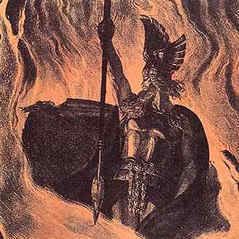 The Ansuz rune
The Ansuz rune
On page 51 of the English-speaking translation of 'The Secret of the Runes," the description of the Ansuz rune caught my attention. The names attached to it, as well at the shape of the rune itself, were so different from the modern depiction that I actually had to look it up. List's "Ansuz rune" depicted the two lines from the stem as: 1) Coming from almost the top, all the way to the bottom; and 2) Coming from the center, all the way to the bottom. A little like the image here, except that the lines were to the opposite side. Actually, there were many variations of this symbol; apparently starting from the Phoenicians, and migrating to the Etruscans, and eventually making it's way all the way to Iceland. I suppose this reality wouldn't be very popular in a lot of Odinist or runic circles; however, it could be thought of as a link tying together cultures which in many ways came to define "the West." In von List's day, this tie-in probably wasn't part of the historical consensus. Not that we should always agree with "the consensus," but it apparently was not perceived as anything but Germanic in origin. Of course, many aspects of the runes changed over many centuries, fitting into the mythology of the native people, like the Teutonic people.
**************************************************
The Thora Design website's description of this rune:
Ansuz literally means "god". But to early germanic people, this rune was associated with the "breath of god" in this case, Odin. Odin came and breathed air into inanimate beings which came to life and aquired consciousness. For these reasons air, the spoken word, communication, higher consciousness and Odin are all tied to this rune.
**************************************************
The a-rune ᚨ, Younger Futhark ᚬ was probably called *ansuz in Proto-Germanic, to which the Norse name Æsir is attributed.
The shape of the rune is likely from Neo-Etruscan a (EtruscanA-01.png), like Latin A ultimately from Phoenician aleph.
Its name survives only in the Icelandic rune poem as óss, however, referring to Odin, identified with Jupiter:
ᚬÓss er algingautr
ok ásgarðs jöfurr,
ok valhallar vísi.
Jupiter oddviti.
Óss is aged Gautr
and prince of Ásgardr
and lord of Vallhalla.
chief Jupiter
The Norwegian rune poem, óss has a meaning of "estuary" while in the Anglo-Saxon one, Futhorc ōs ᚩ has the Latin meaning of "mouth". The Younger Futhark rune is transliterated as ą to distinguish it from the new ár rune (ᛅ), which continues the jēran rune after loss of prevocalic *j- in Proto-Norse *jár (Old Saxon jār).
Since the name of Gothic a.svg a is attested in the Gothic alphabet as ahsa or aza, the common Germanic name of the rune may thus either have been *ansuz "god", or *ahsam "ear (of corn)".
A variant of the rune is Futhorc æsc ᚫ "ash." The Latin ligature æ in Old English was called æsc after the rune. Another variant is ac "oak" ᚪ.
**************************************************
The Romans confused the issue by "attaching" Roman gods to the gods of the newly occupied peoples in order to make colonization easier. For example, attaching Wotan to Mercury, as well as many other examples of this. Although many put the blame squarely on the Romans for dismantling the native spiritual beliefs of the north; actually Charlemagne possibly did more to actually force these ancient traditions out of existence in favor of Christianity, than did the Romans.
**************************************************
os, as, ask, ast = Ase [i.e., one of the Æsir], mouth, arising, ash, ashes.
A fourth still I know, when someone throws
my arms and legs into fetters:
as son as I sing it, I can go forth,
from my feet fall the fetters
the hasp fall from my hands.
The mouth, the power of speech! Spiritual power working through speech [power of suggestion] bursts physical fetters and gives freedom, it itself conquers all conquerors, who only gain advantages through physical force, and it destroys all tyranny.* Therefore: "Your spiritual force makes you free!"
*In the struggle for existence, the people [Volk] who always remain lasting winners are those who develop themselves with the preservation of their moral force. With the disappearance of morality, higher spiritual and intellectual rank is also lost, as history--the "Final Judgement"--will prove.
**************************************************
I thought that I would inject just a few further thoughts on the "magical element" to some of these studies. First of all, that element is present in native pagan spiritual traditions of many parts of the world. This element can simply be ignored, if one desires. My current belief is that it would be best to do so. The natural way seems to be inspiration, mixed with spiritual growth, tied to ancestral focus, and just using what's between your ears in a pragmatic way, can get you to where you want to go in life. Without "magic." Magic can lead one into trouble, because few understand this power of nature, which is like any other instrument in that it can be used for positive or negative ends.
I believe that the magician Criss Angel is a very high initiate of some type of secret order. Although some of his entertaining stunts are illusions; some are indeed "magic." Levitation, for example, goes clear back into the ancient world. This is how stones, weighing hundred of tons, were placed. I have no idea of how it's done, but I do know that it involves creating an intrinsic gravitational force for an object. In other words, "weightlessness." Angel's motto is "Mind, Body, and Spirit." That almost sounds like a Listian concept. Also, Angel has spoken often of "the power of suggestion," which again, ties right into what we're looking at here with List's Ansuz rune.
.


No comments:
Post a Comment